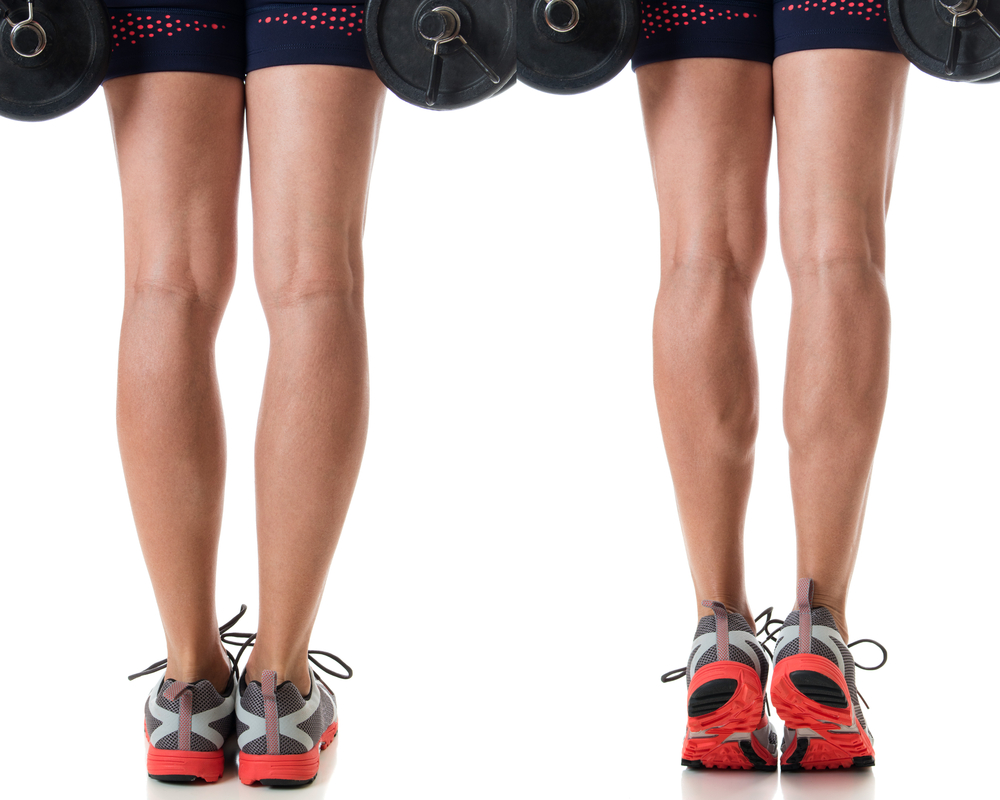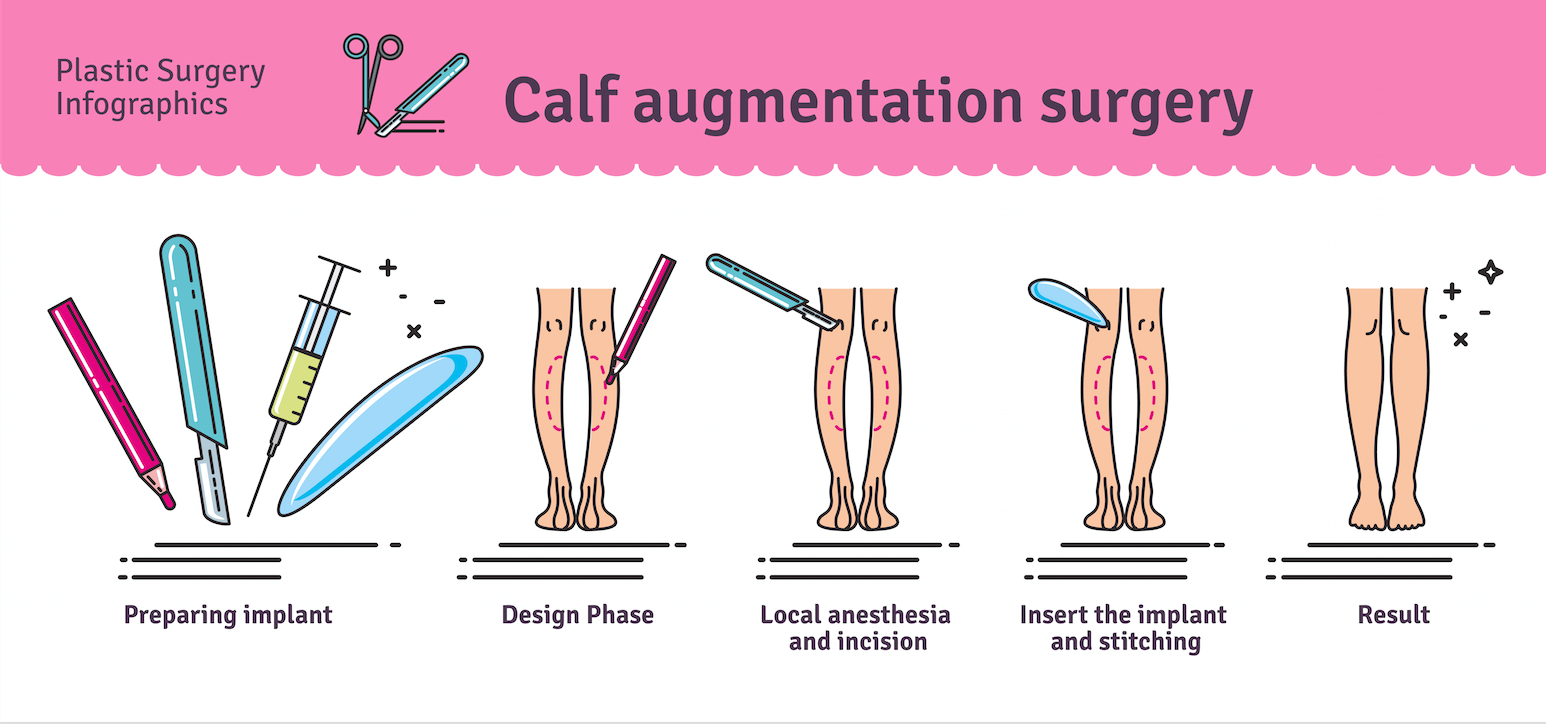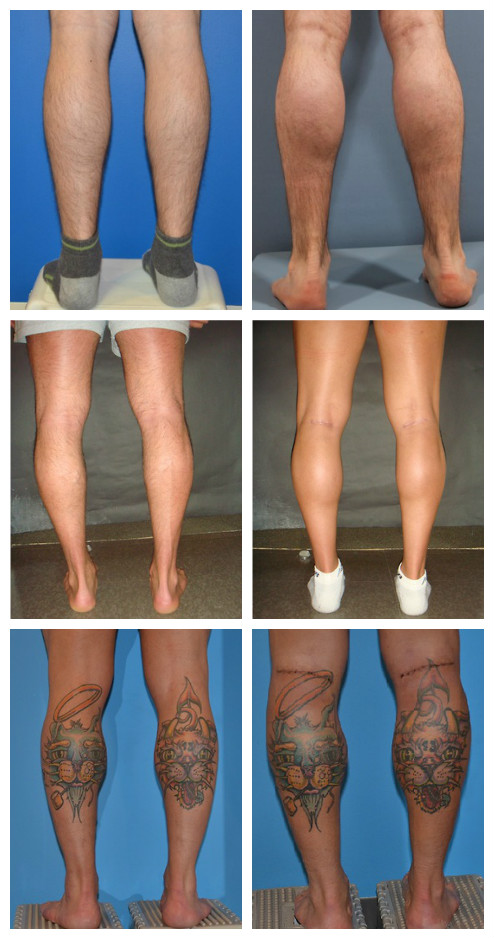- Solid silicone and silicone gel implants are the most common types of calf implants
- Almost everyone returns to their full normal activities within four to six weeks of their operation
- The average cost for calf implant surgery in the United States falls between $4,500 and $6,500
Augmenting one’s calves typically calls for implants to be inserted, and while most patients requesting the procedure do so for aesthetic reasons, implants are also frequently required to correct issues with the lower legs resulting from birth defects, disease, or injury.
Different types of calf implants
While nowhere near as varied as breast implants, calf implants do come in different types and sizes, each with their arguable advantages and disadvantages. Of these, solid silicone and silicone gel implants are far and away the most common.
However, while still preferred by some surgeons, one big problem with the silicone gel calf implants is that they carry the risk of capsular contracture, albeit this is far more common with breast implants than calf implants. Regardless, it remains a consideration.
On the other hand, solid silicone implants sometimes leave an edge you can actually even feel if they’ve been placed too close to the surface. Which is one more reason why, when solid silicone implants are used, submuscular placement is recommended.
Dr. Marc DuPéré, a board-certified plastic surgeon Toronto, Ontario, mentions how in Canada silicone-gel implants have not been approved for use by the federal government (Health Canada to be a little more precise, Canada’s equivalent to the FDA), but that it makes no difference to him anyway. He says that ever since he first started performing these surgeries some 15 years ago, he’s been perfectly content using the solid calf implants.
“The newer [solid] implants are in fact very soft and pliable and do a fine job of mimicking a toned, athletic muscle – which is what most patients aspire to,” explains DuPéré. “These soft but solid implants are also more resistant to forces [pressure] created by strenuous lower body activities. Even better though, is that they can’t rupture. Plus, solid silicone implants come in a greater variety of styles and may be carved into custom shapes before surgery to accommodate asymmetrical muscles.”
Procedure
Calf augmentation is performed under general anesthesia or a local anesthetic with IV sedation and takes approximately two-and-a-half hours to complete.
Over the course of your initial consultation with a qualified plastic surgeon, your legs will be measured to determine the appropriate size of your implants.
As for the procedure itself, once you’ve been anesthetized and are good and sedated, an incision is first made behind the knee, a location typically chosen because it’s difficult to detect scars there afterward.
A pocket is then created between the muscle and fascia before the implants are studiously placed within the muscle of the calves. Interestingly, while women typically only want the inner – or medial – calf filled out, men are more likely to request larger augmentation of the medial and lateral (outer) calves.
Recovery
For the first few days following surgery your lower legs will likely be swollen and slightly bruised. Your doctor will prescribe the appropriate medications to minimize discomfort over this period. It’s important to try and keep your legs elevated for the first two days post-op to alleviate the swelling, but depending on a variety of factors, your doctor might also encourage you to try walking again on the second day. Much will depend on your individual circumstances.
Most people walk stiffly for the first couple of weeks following calf augmentation surgery, but a normal gait usually returns to them by the beginning of week three, if not sooner.
Recovering patients need to avoid any particularly strenuous exercise, like weight training and/or running, for up to two months afterward.
And finally, don’t let yourself get too discouraged after a few weeks of possibly feeling compromised from all this relative inactivity. Remember, almost everyone returns to their full normal activities within four to six weeks of their operation.
Dr DuPéré points out how “any body implant involving muscles will demand recovery time, especially when linked to ambulation, as is the case with hip, calf and buttock implants. And because they’re required for walking, running and standing,” notes DuPéré, “calf augmentation is no exception. Most of my patients with one implant per leg can return to doing desk work within 2 weeks, while the vast majority have returned to normal ambulation after 2-4 weeks.”
Recovery from calf enlargement also sometimes depends on the actual placement of the implants. Placement just beneath the fascia is preferred in many cases because it’s less invasive and offers a faster and easier recovery than implants placed within the muscle.
On the downside, however, this placement can create difficulties because, should the implant rotate, it will result in a calf defined by an implant, not muscle, which clearly isn’t the idea. So while submuscular placement demands a few more days of recovery time, the implants are more secure and the results more natural.
Risks
As with any surgery, there are risks associated with calf implant surgery. Among these are rare surgical complications like nerve or vascular damage, adverse reaction to anesthesia, hematoma, infection, changes in sensation, and scarring. Other risks associated with calf implants include slippage and asymmetry.
Most if not all of these risks can be minimized by simply following the instructions your surgeon provides you. It’s also wise to try and locate a plastic surgeon near you who already has extensive experience performing implant procedures, calf implants in particular.
Further, because it impedes healing and vastly increases the risk of developing complications, you’ll need to quit smoking at least two weeks prior to surgery and refrain from consuming tobacco straight through to the final days of your recovery.
Some medications and supplements increase your risk of bleeding during surgery, so be sure to provide your surgeon with a thorough list of all the medications you take, including over-the-counter medications and natural supplements. Your doctor will also provide you with a full list of medications you’ll need to discontinue prior to surgery.
Cost
The cost of calf implant surgery depends on several factors, among them being your location, the level of experience and reputation of your plastic surgeon, the size and type of implant chosen, the cost of the anesthesia along with any surgical facility fees. As a ballpark figure, the average cost for calf implant surgery in the United States falls between $4,500 and $6,500.
Dr DuPéré says that in Canada it’s important to remember that the cost of a calf augmentation is all-inclusive, that there are no extra fees for things like anesthesia. “[In Canada] the cost for one implant per leg is $8,100 and $11,800 for 2 implants per leg.”
Calf augmentation is not covered by insurance when performed for cosmetic reasons, although it may be included in some plans should it be required to fix a deformity or birth defect.
An Interview with Dr. Marc DuPéré, Toronto Aesthetic Plastic Surgeon
Toronto, Ontario’s Dr. Marc DuPéré is one of the premier aesthetic plastic surgeons in Canada. Specializing in body implants, he performs more such surgeries per annum than any other doctor in the country, with approximately 500 successful career calf implant surgeries under his belt.
Zwivel spoke to Dr. DuPéré earlier this week, where he generously answered our questions on this unique procedure. The following are some of the highlights of our conversation.
In general, what are the main reasons why men opt for calf implants? Is it usually for cosmetic reasons or more to correct defects of the lower leg caused by birth defects, disease, or injury? Is it a fairly common procedure?
In my practice I’d say 85-90% of the males coming to me requesting calf augmentation do so for cosmetic purposes, opting for either one, or – as is often the case with bodybuilders – two implants per leg. The other 10-15% will be to correct an asymmetry such as those caused by poliomyelitis (an infection now practically eradicated in North America but still seen in developing countries), or after surgeries to correct club feet surgeries and/or trauma to lower legs, etc.
Because I’m likely the busiest surgeon in Canada when it comes to body implants, patients come to me from all corners of the country, so calf augmentation is a very common procedure for me, averaging 6-10 implant surgeries every month.
I understand that solid silicone and silicone gel implants are both available for calf augmentation. Could you please explain the advantages and drawbacks of each? Do you personally prefer one over the other, and if so, why?
The FDA equivalent in Canada will not approve silicone gel for anything other than breast implants, so my experience over the past 14-15 years has been limited to the solid calf implants, which is fine. The newer [solid] implants are in fact very soft and pliable and do a fine job of mimicing a toned, athletic muscle – which is what most patients aspire to.
Do calf implants come in different shapes and sizes? If they do, is it primarily for cosmetic reasons, the way some women want D-size breasts while others prefer C-size?
Yes, they do come in various sizes and shapes, although the options are much less numerous than with breast implants. Patients will often express their wish for an implant of a specific size, but the implants always have to be able to fit within the fascial envelope.
You see, each muscle of the body has a tight and strong envelop called the fascia, which is analogous to the tough white layer seen on meat flanks at the butcher. The calf implants are inserted under the muscle’s fascia, and respecting the size of the fascial pocket assures the implants won’t migrate. So when patients first come to see me, I will measure their calf which then guides me toward determining the properly sized implant to recommend. The good news is that most males can fit the largest implants. Ladies, on the other hand, often opt for something more subtle, in which case we’ll just order something a little smaller for them.
What are the pros and cons between subfascial placements or having implants actually placed within the muscle? Can the final outcome be significantly different?
I have always placed every one of my calf implants under the fascia. It tends to be safer as putting them deeper carries a higher risk of injury to the crucially important neurovascular structures responsible for foot and ankle function. I’ve never had any issues with calf implant visibility or edge palpability. Calf implants have very fine, tapered edges and the fascia is very strong. I see implanting deeper as more of an advantage with buttock augmentations, as buttock implants are more palpable, more easily ‘touched’ by others, and more subject to gravity than calf implants.
Do men and women tend to have different objectives/desires for this surgery? I don’t know how true this is, but I’ve read women typically want only the inner or medial calf filled out, while men are more likely to request larger augmentation of the medial and lateral (outer) calves. Why would this be the case?
I would say that over 98% of women and 75% of males are extremely happy with the augmentation of the inner head of the gastrocnemius alone. It restores their confidence and the recovery period is shorter. Men feel more confident wearing shorts, and ladies wearing short dresses and high heels.
For the body builders or males who aspire to see a very large increase in the circumference of their lower legs, then two implants per legs is what will be performed. Recovery takes a little longer, the incision is slightly longer, and the cost of the operation is slightly higher as well.
I would imagine a surgery like this would require significant recovery time, more so than many other procedures. Is this true? Just how much recovery time is required? How long does it take before patients can walk comfortably again?
All body implants involving muscles demand some recovery time, especially when linked to ambulation like hip, calf and buttock implants. Because the calves are required for walking, running and standing, a certain period of recovery time is always going to be necessary. Crutches are recommended to help with the initial discomfort.
Most of my patients with one implant per leg can return to doing desk work within 2 weeks, while the vast majority have returned to normal ambulation after 2-4 weeks. No gym activities involving the lower body are allowed for a minimum of 8 weeks though.
Do patients coming to you for calf augmentation ever back down once they learn just what is involved – the length of recovery time, etc?
No. My first interaction with potential patients is often via email and in my replies I’ll usually mention what’s involved with the recovery. Most patients have also read about the procedures I offer on my website, or in my blogs, or maybe they’ve seen one my videos or been referred to me by previous patients, so the majority of them are already relatively well-informed.
Plus, patients are usually so excited about the procedure they’re fully prepared to invest the time required for the recovery. In this respect, it’s no different than committing to a facelift. The gains and benefits far outweigh the few weeks of downtime. Besides, after the first 3-5 days when pain pills are required, most patients are able to resume most kinds of desk work, slowly, at home.
Is it a fairly painful procedure?
Pectoral, hip, buttock and calf augmentation surgery all come with some pain as each involves surgery within a muscle. On average, most patients will require pain medications for 3-5 days post-surgery. Pain is obviously most important when the muscle operated upon is required to work, like the calves. Consequently, when patients just lay down to read or watch TV, the pain is much lighter.
That being said, I always encourage patients to walk a bit in the house after any surgery in order to minimize risk of blood clots in the legs.
Are there more potential significant risks with calf augmentation than other cosmetic procedures?
Things like scarring, asymmetry and pain are obvious. Rare complications would be visibility, palpability and implant migration. Rarer complications still might include bleeding, infection and seromas (clear liquid around the implant, requiring serial aspirations at the bedside).
One very serious yet extremely rare complication would be compartment syndrome, something I’ve personally never encountered with calf augmentation surgery even when using two implants per leg, but still something I discuss with all of my patients. Compartment syndrome is when there is excessive swelling within the fascia post-surgery; the fascia being very tight and not easily and quickly “stretchable”.
Instead of having the skin expanded (as breast tissue would do away from the ribs) the swelling in the fascia leads to progressive compression of the inner nerve, vein and artery of the lower leg. The first symptom would be pins and needles in the toes, indicating compression of the nerve. Fortunately, most of those “pins and needle” sensations are relieved by loosening the dressings (compression socks) and elevating the legs on a few pillows.
Should this fail, my patients have my phone number and I can just go meet them at my office and release a few stitches to evacuate any swelling. But again, it’s a potential situation that has not yet happened in over 14 years.











